If you’re looking for the best smart home routers in 2025, I recommend options like the TP-Link AX1800, AX5400, AXE5400, and the NETGEAR WiFi 7 RS140, which offer cutting-edge speeds, multi-device capacity, and future-proof features like Wi-Fi 6E and Wi-Fi 7. Devices with mesh compatibility and advanced security also stand out for seamless connectivity. To find the perfect match for your home, keep exploring the options that suit your needs and budget.
Key Takeaways
- Prioritize routers supporting Wi-Fi 6, Wi-Fi 6E, or Wi-Fi 7 for future-proof, high-speed smart home connectivity.
- Look for models with advanced security features like WPA3, VPN support, and integrated security services.
- Choose routers with seamless compatibility with smart home devices and voice assistants such as Alexa or Google Home.
- Opt for devices with robust coverage, multi-gig ports, and mesh capabilities to eliminate dead zones across large or multi-floor homes.
- Consider user-friendly setups, remote management, and parental controls for convenient and secure smart home integration.
TP-Link AX1800 WiFi 6 Router (Archer AX21)

If you’re looking for a reliable, high-performance router that can handle multiple devices simultaneously, the TP-Link AX1800 WiFi 6 Router (Archer AX21) is an excellent choice. It offers dual-band 802.11ax technology with speeds up to 1.8 Gbps, thanks to OFDMA and MU-MIMO. The four high-gain antennas and Beamforming extend coverage and strengthen signals, even at a distance. Easy to set up via IP login, it supports VPN, parental controls, and guest networks for added security. Compatible with major ISPs, it improves streaming, gaming, and device management while providing industry-leading support and a 2-year warranty.
Best For: households or small offices seeking a reliable, high-speed WiFi 6 router that manages multiple devices efficiently and offers extended coverage.
Pros:
- Supports dual-band 802.11ax technology with speeds up to 1.8 Gbps for fast streaming and gaming
- Four high-gain antennas and Beamforming enhance coverage and signal strength across large areas
- Easy setup via IP login with robust security features including VPN, parental controls, and guest networks
Cons:
- Requires a compatible modem, which may add to initial setup costs
- Real-world performance can vary based on environment and obstacles
- Advanced features like WiFi 7 support are not included in this model
TP-Link AX5400 WiFi 6 Router

The TP-Link AX5400 WiFi 6 Router is an excellent choice for households that demand ultra-fast, reliable internet across multiple devices. It delivers gigabit speeds up to 5400 Mbps, perfect for streaming 8K videos, gaming, and heavy browsing simultaneously. Equipped with advanced WiFi 6 features like OFDMA, MU-MIMO, and HE160, it ensures stable, high-capacity connections. Its six antennas, beamforming, and high-power design provide extensive coverage, even in large or multi-floor homes. The sleek, vented design promotes efficient heat dissipation, keeping the router cool during prolonged use. Easy to set up via the TP-Link Tether app, it offers robust security and seamless mesh networking with OneMesh.
Best For: households and users requiring ultra-fast, reliable WiFi coverage across multiple devices in large or multi-floor homes.
Pros:
- Supports gigabit speeds up to 5400 Mbps with advanced WiFi 6 technology for smooth streaming and gaming.
- Extensive coverage with six antennas, beamforming, and high-power design ensures stable connections even in large spaces.
- Easy setup via the TP-Link Tether app, with robust security features and seamless mesh networking support.
Cons:
- Some users have reported occasional connectivity issues with certain devices like PS5 over WiFi 6.
- The optional HomeShield Pro subscription costs $5.99/month after the free trial.
- The design, while sleek, may be bulkier than some compact routers, potentially affecting aesthetic preferences.
TP-Link AXE5400 Tri-Band WiFi 6E Router
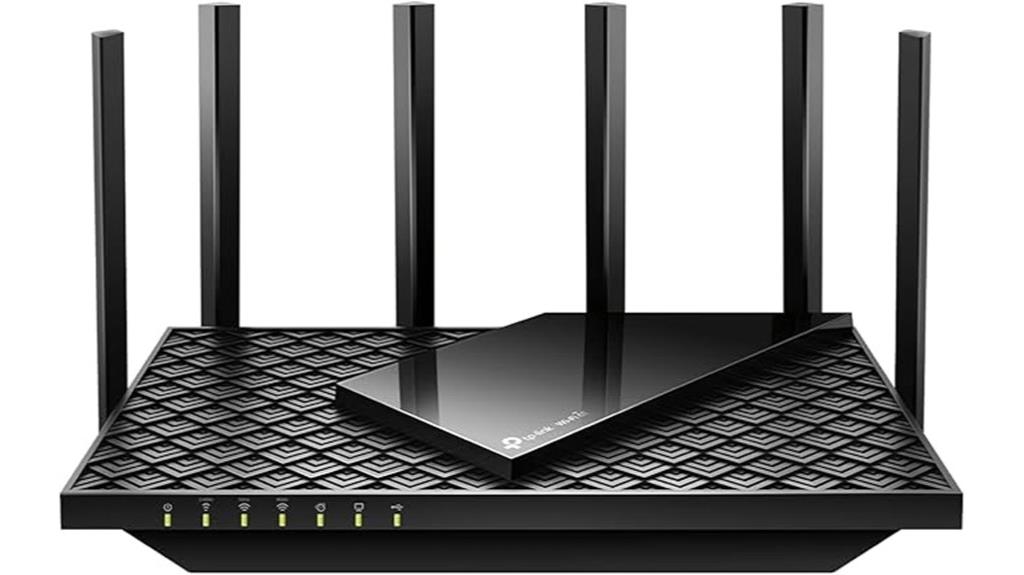
For anyone seeking a high-performance router that can handle multiple devices seamlessly, the TP-Link AXE5400 Tri-Band WiFi 6E Router stands out with its impressive 5400 Mbps speed and tri-band setup. It features a 6 GHz band (2402 Mbps), a 5 GHz band (2402 Mbps), and a 2.4 GHz band (574 Mbps), providing ample bandwidth for gaming, streaming, and video calls with near-zero latency. Powered by a 1.7 GHz quad-core CPU and 512 MB memory, it ensures smooth multitasking and robust performance. With OneMesh support and WPA3 security, it offers reliable whole-home coverage and enhanced security for your connected devices.
Best For: households or small offices requiring high-speed, reliable WiFi coverage for multiple devices, gaming, streaming, and video conferencing.
Pros:
- Tri-band WiFi 6E with up to 5400 Mbps speeds for seamless multitasking
- Supports OneMesh technology for whole-home coverage and easy expansion
- Equipped with a powerful 1.7 GHz quad-core CPU and 512 MB memory for robust performance
Cons:
- Requires a compatible modem for internet access with most ISPs
- Higher price point compared to dual-band routers with similar basic features
- Advanced features like VPN setup may require technical knowledge to configure
TP-Link AC1200 WiFi Router (Archer A54)
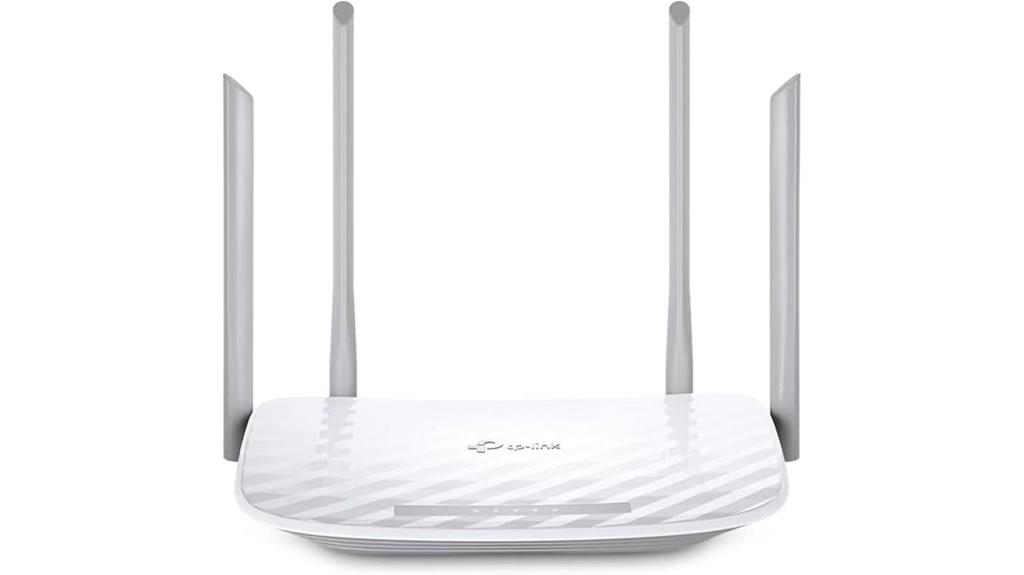
With its support for simultaneous dual-band connections of up to 1200 Mbps, the TP-Link AC1200 WiFi Router (Archer A54) is an excellent choice for users seeking reliable, high-speed internet throughout their home. Its 2.4GHz band offers 300 Mbps, while the 5GHz band delivers 867 Mbps, ensuring smooth streaming and gaming. Four external antennas provide stable coverage and strong signals across multiple rooms. The router includes four Ethernet ports, supports IPTV optimization, and features advanced security with WPA3. Plus, it’s Mesh-compatible with EasyMesh, making it easy to expand your WiFi coverage effortlessly. Managing the network is simple via the TP-Link Tether app.
Best For: home users and small families seeking reliable, high-speed WiFi coverage with easy expansion options.
Pros:
- Supports simultaneous dual-band connections up to 1200 Mbps for smooth streaming and gaming
- EasyMesh compatibility allows seamless coverage expansion with compatible extenders or routers
- User-friendly management via the TP-Link Tether app with security features like WPA3
Cons:
- Only four Ethernet ports may be limiting for wired device-heavy setups
- No USB ports for sharing storage or printers
- 10/100 Mbps Ethernet ports are slower compared to gigabit options
TP-Link AC1900 Smart WiFi Router (Archer A8)
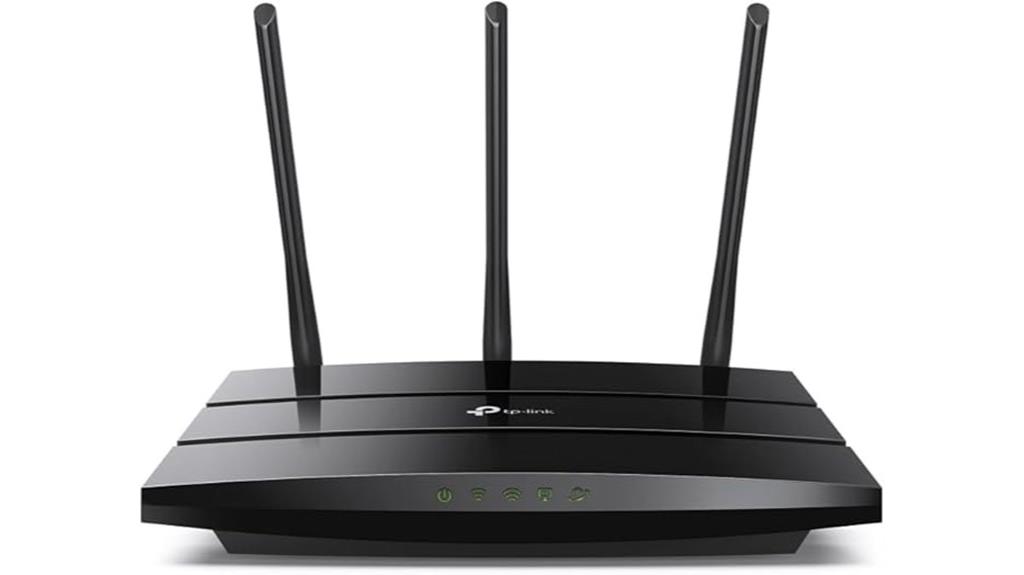
If you’re looking for a reliable router that seamlessly supports multiple devices and high-speed streaming, the TP-Link AC1900 Smart WiFi Router (Archer A8) is an excellent choice. It offers dual-band Wave 2 technology, providing 600 Mbps on 2.4GHz and 1300 Mbps on 5GHz, ensuring fast, stable connections. With MU-MIMO and three data streams, it efficiently handles multiple devices simultaneously. The router features four Gigabit LAN ports and a WAN port for wired connections, plus support for OneMesh to extend coverage easily. Parental controls add an extra layer of security, making this router ideal for gaming, streaming, and smart home setups in 2025.
Best For: families, gamers, and smart home users seeking high-speed, reliable WiFi coverage with easy device management.
Pros:
- Supports dual-band Wave 2 technology with fast speeds of 600 Mbps on 2.4GHz and 1300 Mbps on 5GHz
- MU-MIMO and three data streams for efficient handling of multiple devices simultaneously
- Easy coverage extension with OneMesh support and multiple Gigabit ports for wired connections
Cons:
- No USB port available for shared storage or printer connection
- Requires a modem for most internet service providers, which may add to setup complexity
- Some advanced features may need additional configuration or compatible extenders
TP-Link AX3000 Wi-Fi 6 Router Archer AX55
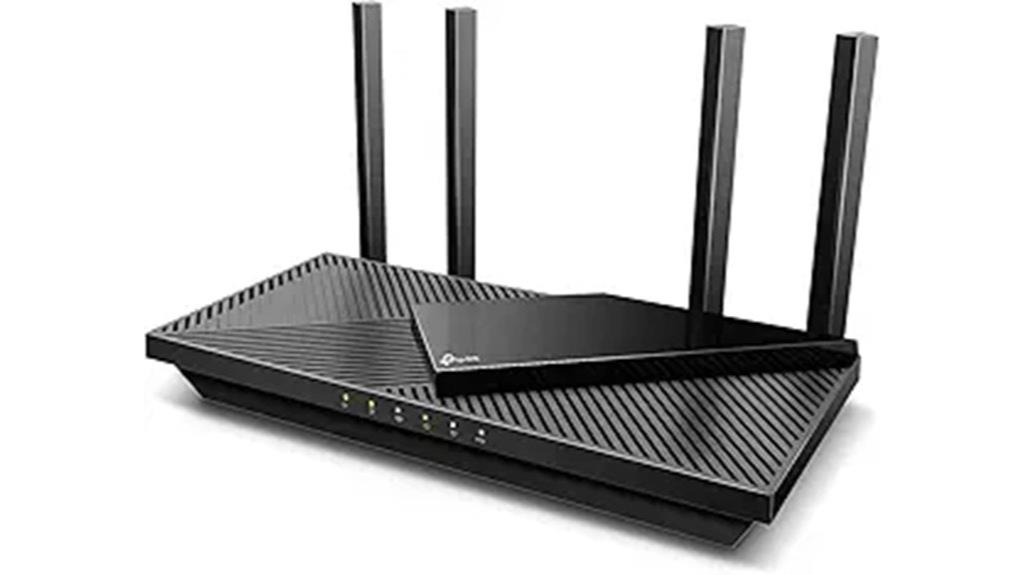
The TP-Link AX3000 Wi-Fi 6 Router Archer AX55 stands out as an excellent choice for households seeking fast, reliable Wi-Fi coverage across multiple devices. It delivers next-gen Gigabit speeds—2402 Mbps on 5 GHz and 574 Mbps on 2.4 GHz—perfect for streaming and downloads. The router features OFDMA and MU-MIMO tech, reducing latency and improving device efficiency. Four high-gain antennas with Beamforming extend coverage, while a robust cooling system maintains performance. Compatible with Amazon Alexa and packed with security features like TP-Link HomeShield, the AX55 offers seamless, secure connectivity, making it a top contender for smart homes in 2025.
Best For: households and smart homes in need of fast, reliable Wi-Fi coverage with strong security features and seamless device management.
Pros:
- Supports next-gen Gigabit Wi-Fi 6 speeds for smooth streaming and fast downloads
- Extensive coverage with four high-gain antennas and Beamforming technology
- Advanced security with TP-Link HomeShield and compatibility with Amazon Alexa
Cons:
- May be more expensive than basic routers without Wi-Fi 6 technology
- Setup and configuration can be complex for less tech-savvy users
- The device’s size and antenna placement may be less discreet in minimalistic home environments
TP-Link Archer BE6500 Wi-Fi 7 Router
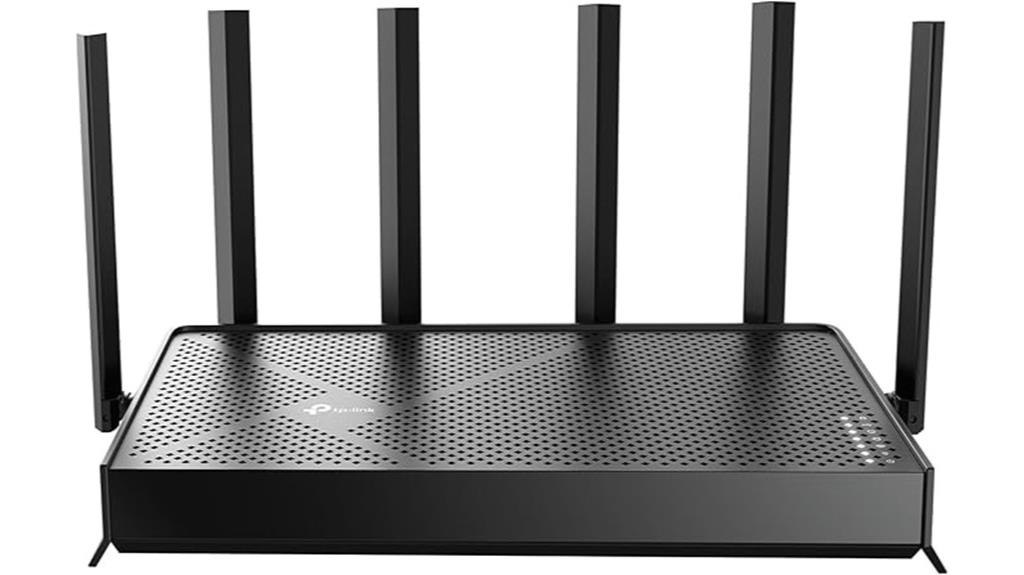
For those seeking a future-proof router that can handle multiple devices and demanding activities, the TP-Link Archer BE6500 Wi-Fi 7 stands out. It supports dual-band Wi-Fi 7 with Multi-Link Operation, Multi-RUs, and 4K-QAM, delivering speeds up to 6.5 Gbps across a large coverage area of 2,400 sq. ft. and supporting around 90 devices simultaneously. Equipped with six antennas and Beamforming, it offers strong, reliable connections throughout multi-story homes. Features like MU-MIMO, OFDMA, advanced security with WPA3, and easy setup via the TP-Link Tether app make it a versatile, secure, and high-performance choice for modern smart homes.
Best For: home users and tech enthusiasts seeking a future-proof, high-speed Wi-Fi 7 router capable of supporting multiple devices across large and multi-story homes with advanced security features.
Pros:
- Supports blazing-fast speeds up to 6.5 Gbps with Wi-Fi 7 technology, ideal for demanding activities like streaming, gaming, and large downloads.
- Extensive coverage up to 2,400 sq. ft. with six antennas and Beamforming for strong, reliable connections throughout large or multi-story homes.
- Easy setup and management via the TP-Link Tether app, along with comprehensive security features including WPA3 and HomeShield.
Cons:
- Higher price point compared to older Wi-Fi 5 and Wi-Fi 6 routers, which may be a consideration for budget-conscious users.
- Requires compatible devices to fully utilize Wi-Fi 7 features; older devices may not see significant improvements.
- The physical size and multiple ports may be excessive for small apartments or users with minimal wired connectivity needs.
NETGEAR Nighthawk WiFi 6 Router (RAX54S)
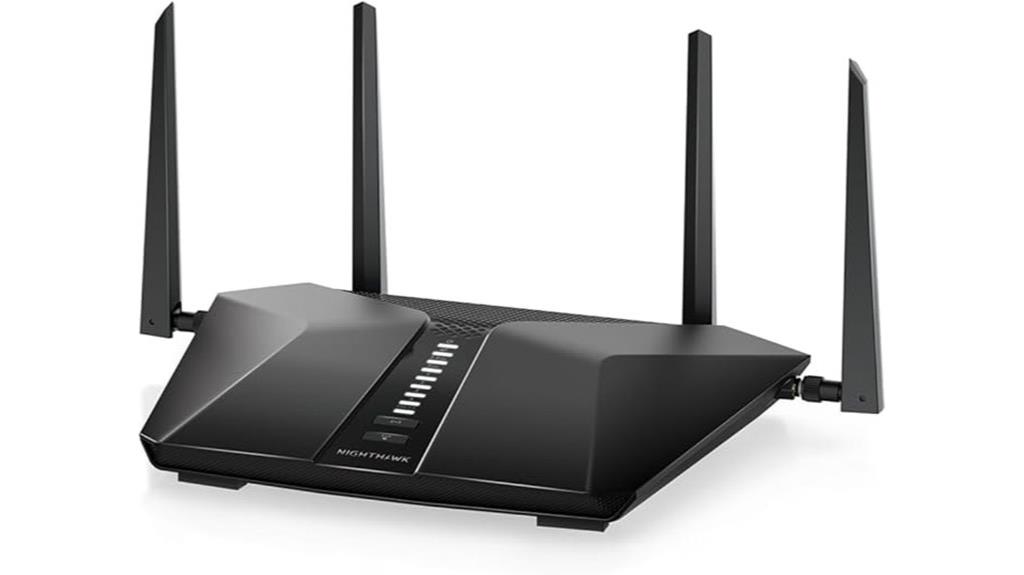
The NETGEAR Nighthawk AX5400 WiFi 6 Router (RAX54S) stands out as an excellent choice for large households and busy homes that need fast, reliable internet across multiple devices. It offers AX5400 speeds up to 5.4 Gbps, covering up to 2,500 sq. ft., and supports up to 25 devices simultaneously. The router features a 1.5GHz triple-core processor, WiFi 6 technology with OFDMA, and high-power amplifiers for extended range. Easy to set up via the app, it provides strong security with NETGEAR Armor and parental controls. Users praise its consistent performance, making it ideal for streaming, gaming, and smart home devices.
Best For: households and busy homes requiring fast, reliable WiFi coverage for multiple devices, streaming, gaming, and smart home integration.
Pros:
- Fast AX5400 WiFi speeds up to 5.4 Gbps with extensive coverage up to 2,500 sq. ft.
- Supports up to 25 devices simultaneously with reliable performance.
- Strong security features including NETGEAR Armor and parental controls.
Cons:
- Higher price point compared to some other routers with similar features.
- App-based setup may be inconvenient for users preferring simple plug-and-play.
- Lacks support for WiFi 6E and 6GHz band outside the U.S., limiting future-proofing options in some regions.
Dbit N300 Wireless Wi-Fi Router with High Power Antennas
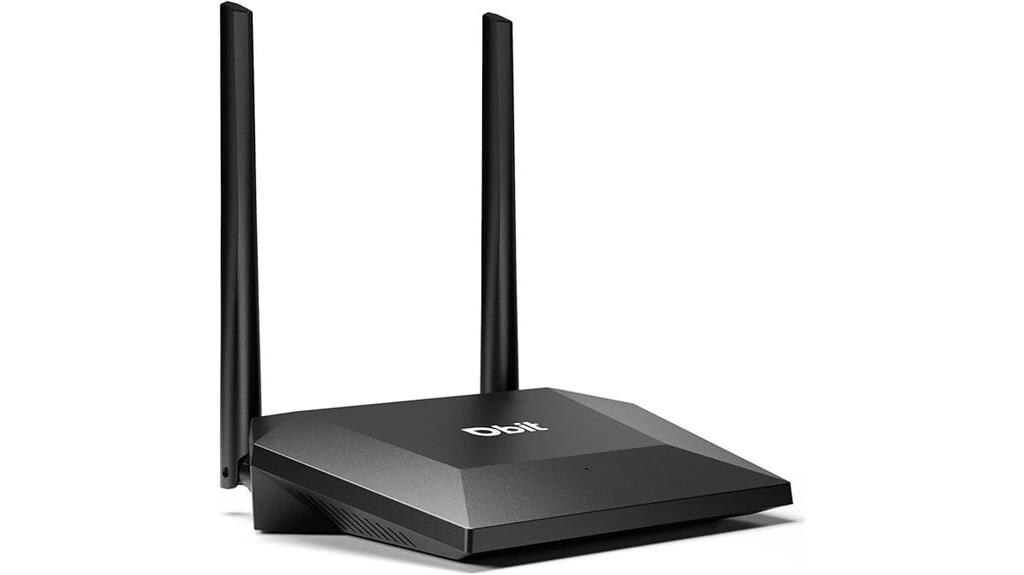
If you’re looking for a reliable and easy-to-use router to support your daily online activities, the Dbit N300 Wireless Wi-Fi Router with High Power Antennas offers an excellent choice. It delivers wireless speeds up to 300 Mbps, perfect for streaming, gaming, and browsing. The dual high-power antennas ensure strong, stable signals and extended coverage, while the four Ethernet ports provide fast wired connections. Setup is quick with the intuitive web UI and WPS button. Plus, parental controls and bandwidth management help you control and optimize your network. Overall, it’s a solid, user-friendly option for reliable home connectivity.
Best For: users seeking a reliable, easy-to-set-up Wi-Fi router with extended coverage and basic network management features for everyday home internet use.
Pros:
- Wireless speeds up to 300 Mbps suitable for streaming, gaming, and browsing
- High power antennas provide strong, stable signals and wider coverage
- Easy setup with intuitive web UI and WPS button for quick device connections
Cons:
- Only four Ethernet ports may be limiting for larger wired networks
- Supports only wireless N standard, which is slower compared to newer Wi-Fi standards
- Lacks advanced features like MU-MIMO or dual-band support
NETGEAR WiFi 6 Router (R6700AXv3)
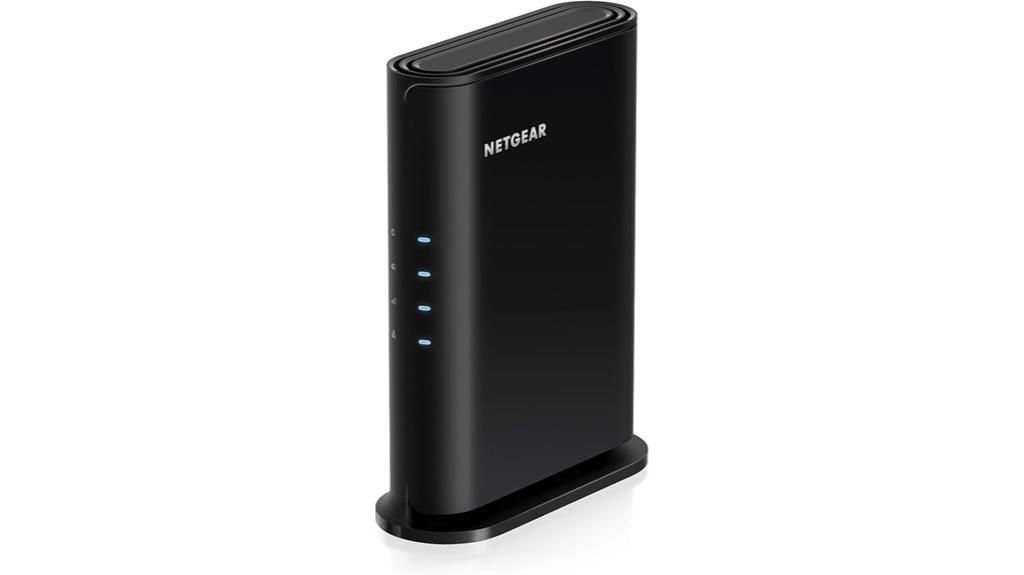
Designed to handle multiple devices seamlessly, the NETGEAR WiFi 6 Router (R6700AXv3) stands out as an ideal choice for small to medium homes where reliable, high-speed internet is essential. It delivers AX1800 speeds up to 1.8 Gbps, supporting WiFi 6 technology, and connects up to 20 devices with strong coverage of up to 1,500 sq. ft.. Its dual-core 880 MHz processor manages streaming, gaming, and video chats smoothly. Equipped with four Gigabit Ethernet ports, it supports wired connections for computers and gaming consoles. Easy to set up via the Nighthawk app, this router offers solid security features, making it a versatile, reliable option for modern smart homes.
Best For: small to medium-sized households seeking reliable, high-speed WiFi 6 connectivity for multiple devices with easy setup and strong security features.
Pros:
- Supports WiFi 6 technology with speeds up to 1.8 Gbps, ideal for streaming and gaming
- Easy setup and management via the Nighthawk app, even for beginners
- Covers up to 1,500 sq. ft. with strong signal strength and support for multiple devices
Cons:
- Some users experience disconnections, particularly on the 5GHz band
- Reliability concerns with potential device failure after extended use
- Subscription fees for enhanced security and advanced features may be necessary for full functionality
TP-Link Tri-Band WiFi 7 Router (Archer BE550)
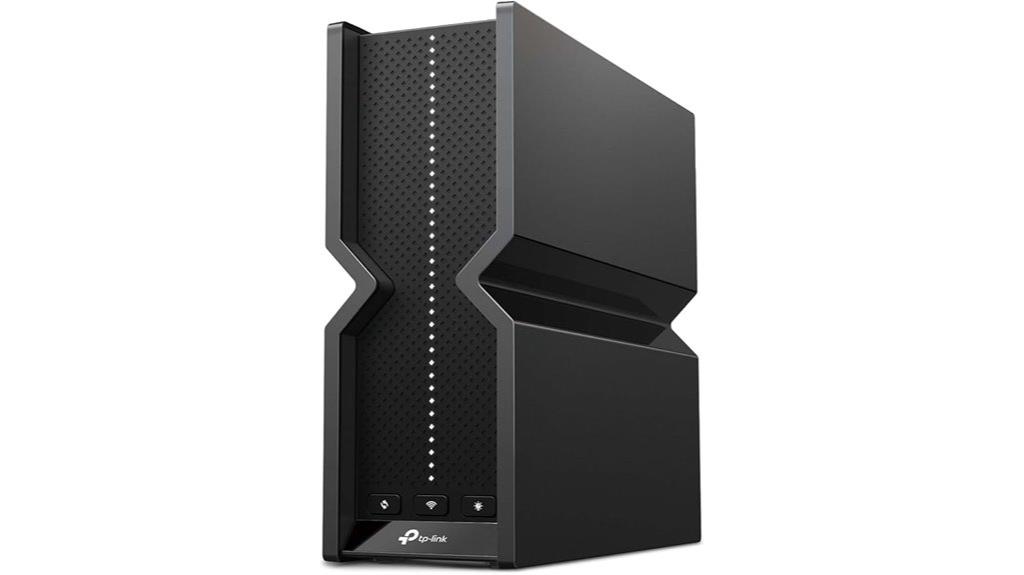
For anyone seeking ultra-fast, reliable Wi-Fi across a large home, the TP-Link Tri-Band WiFi 7 Router (Archer BE550) stands out with its cutting-edge Wi-Fi 7 technology and extensive coverage features. It delivers impressive speeds up to 5760 Mbps on the 6 GHz band, perfect for 4K/8K streaming, gaming, and downloads. Its support for EasyMesh allows seamless expansion with compatible devices, reducing dead zones. Equipped with a 2.5G WAN port, six antennas, beamforming, and Wi-Fi optimization, it ensures strong, stable connections. Plus, with TP-Link HomeShield, it offers robust security, parental controls, and IoT protection, making it a future-proof home networking solution.
Best For: households requiring ultra-fast, reliable Wi-Fi coverage for streaming, gaming, and smart home devices across large areas.
Pros:
- Supports Wi-Fi 7 with speeds up to 5760 Mbps on the 6 GHz band for high-performance activities
- EasyMesh compatibility enables seamless expansion and eliminates dead zones
- Equipped with a 2.5G WAN port, six antennas, and beamforming for strong, stable connections
Cons:
- Higher price point due to advanced Wi-Fi 7 technology and features
- Requires compatible devices to fully utilize Wi-Fi 7 speeds and Multi-Link Operation
- Setup and management may be complex for users unfamiliar with advanced networking options
Tenda AC1200 Smart WiFi Router
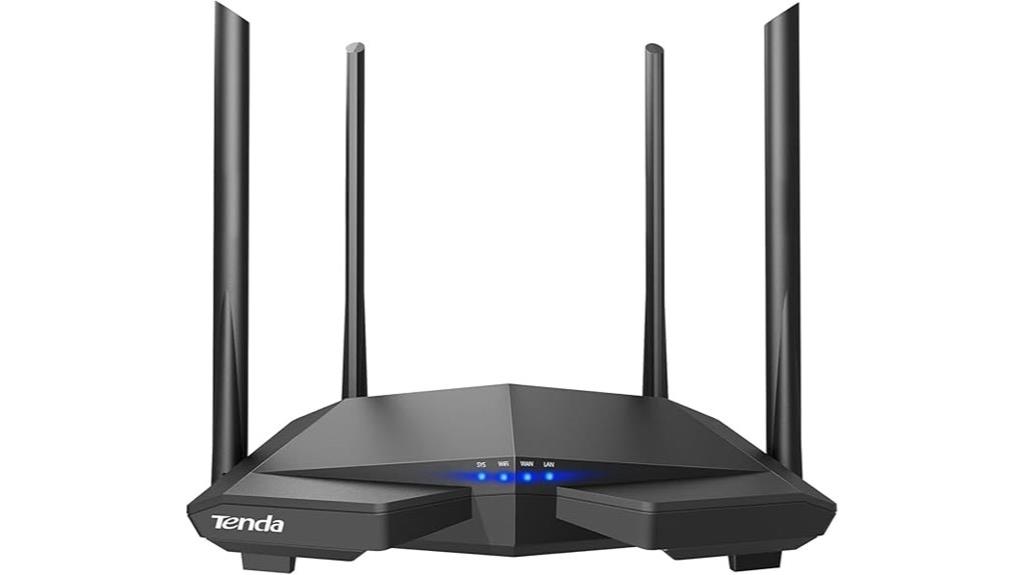
The Tenda AC1200 Smart WiFi Router stands out as an excellent choice for households seeking reliable, high-speed internet coverage without breaking the bank. It offers dual-band Wi-Fi up to 1.2 Gbps, with strong signal coverage thanks to five external antennas and Beamforming technology. Setup is quick via the Tenda app, and it supports MU-MIMO for multiple device connections. Equipped with four Ethernet ports, parental controls, guest WiFi, and remote management, it’s perfect for streaming, gaming, and everyday use. While lacking a USB port and featuring limited port speeds, its affordability and ease of use make it a popular, versatile option for modern homes.
Best For: households seeking affordable, reliable high-speed Wi-Fi coverage with easy setup and versatile features.
Pros:
- Straightforward installation via the Tenda app with quick setup
- Strong signal coverage thanks to five external antennas and Beamforming technology
- Supports multiple devices simultaneously with MU-MIMO and parental controls
Cons:
- Lacks a USB port for file sharing or printer connectivity
- Limited port speed with only 100 Mbps Ethernet ports
- Some reported security vulnerabilities related to IPv6 and potential backdoors
TP-Link WiFi 6 Router (Archer AX10)

If you’re looking to upgrade your home Wi-Fi with a reliable and high-performance router, the TP-Link WiFi 6 Router (Archer AX10) is an excellent choice. It supports all major ISPs and is OneMesh compatible, so you can easily expand your network with extenders. Thanks to Wi-Fi 6 technology, it offers faster speeds and better efficiency for streaming, gaming, and smart home devices. The dual-core 900MHz processor ensures smooth performance across multiple devices, while beamforming technology strengthens signals throughout your home. Plus, with features like parental controls and Alexa compatibility, it’s designed to fit seamlessly into your connected lifestyle.
Best For: households seeking a high-performance, reliable Wi-Fi 6 router that supports multiple devices, smart home integration, and network expansion through OneMesh compatibility.
Pros:
- Supports all major ISPs and is compatible with existing Wi-Fi devices for versatile setup.
- Equipped with Wi-Fi 6 technology, offering faster speeds and improved efficiency for streaming, gaming, and smart home devices.
- Features Beamforming and a powerful dual-core 900MHz processor for enhanced coverage and reliable performance.
Cons:
- May require a modem for most ISPs, adding to setup costs.
- Lacks advanced features like multiple WAN ports or multi-gig Ethernet options.
- Design is relatively basic, with limited customization options for advanced network configurations.
NETGEAR Nighthawk WiFi 7 Router (RS140)

The NETGEAR Nighthawk WiFi 7 Router (RS140) stands out as an excellent choice for gaming, streaming, and demanding multi-device households, thanks to its blazing-fast speeds of up to 5.0 Gbps. It leverages WiFi 7 technology, offering 1.2 times faster speeds than WiFi 6, ensuring smooth performance across all devices. With coverage up to 2,250 square feet and high-performance antennas, it’s perfect for large homes. The router includes a 2.5 Gigabit Ethernet port for multi-gig speeds and three 1 Gigabit LAN ports for wired connections. Its sleek, compact design makes it both powerful and space-efficient, with built-in security features for added protection.
Best For: households or individuals seeking ultra-fast WiFi 7 performance for gaming, streaming, and multiple connected devices in large homes.
Pros:
- Delivers WiFi 7 speeds up to 5.0 Gbps for seamless high-bandwidth activities
- Supports coverage up to 2,250 sq. ft. with high-performance antennas, ideal for large homes
- Includes a 2.5 Gigabit Ethernet port and three 1 Gigabit LAN ports for flexible wired connections
Cons:
- Requires a separate modem for internet service, as it is a router-only device
- May need updates or compatibility checks for existing network infrastructure
- Premium features like NETGEAR Armor may require additional subscription after trial period
KKH WiFi Router with Dual Band AC1200, Gigabit Ethernet, for Home Internet
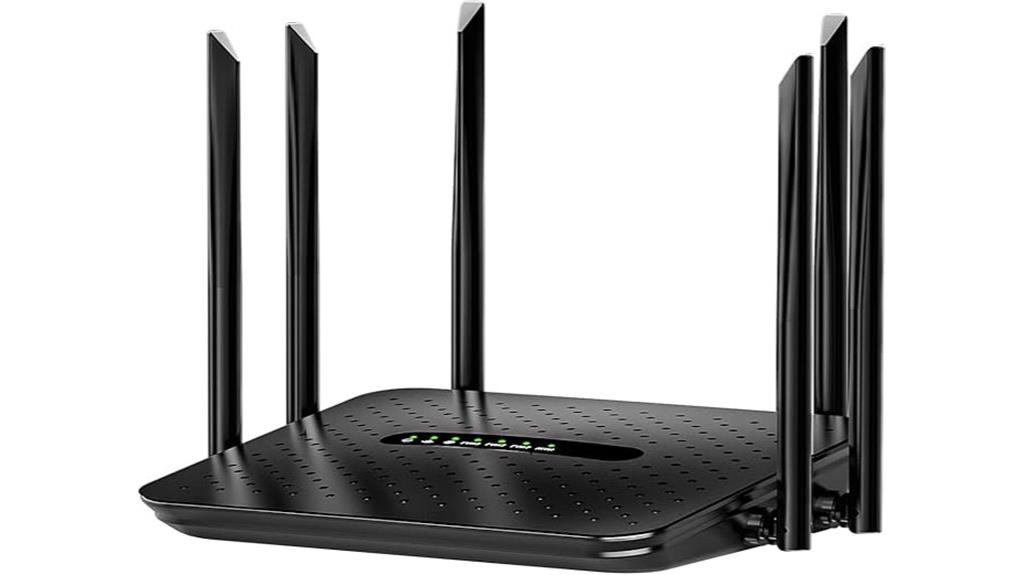
For anyone seeking an affordable, straightforward Wi-Fi solution for their home, the KKH WiFi Router with Dual Band AC1200 offers reliable dual-band speeds and easy setup. It delivers up to 1200Mbps, with 300Mbps on 2.4GHz and 900Mbps on 5GHz, supporting streaming, gaming, and downloads. Equipped with six external antennas, it provides strong, consistent coverage across larger spaces. Compatibility with major ISPs like Spectrum, AT&T, and Xfinity makes installation simple—just a quick 2-step setup. While some users report occasional disconnections, many appreciate its affordability and ease of use for basic home internet needs.
Best For: those seeking an affordable, easy-to-setup Wi-Fi router for basic home internet use with reliable dual-band performance.
Pros:
- Easy 2-step setup process for quick installation
- Supports dual-band speeds up to 1200Mbps, ideal for streaming and gaming
- Equipped with six external antennas for enhanced coverage across larger areas
Cons:
- Some users experience frequent disconnections requiring rebooting
- Lacks advanced security features like MAC address restriction and port forwarding
- Compatibility issues with certain cable modems reported by a few customers
Factors to Consider When Choosing the Top‑Rated Smart Home Router
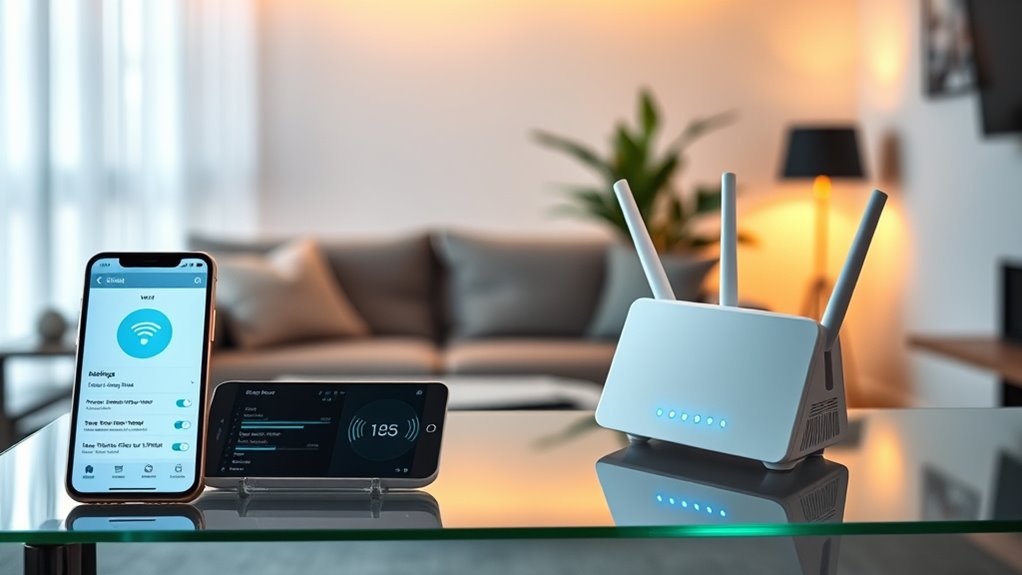
When choosing a smart home router, I focus on speed and bandwidth to keep everything running smoothly. Coverage and device compatibility are also key to ensuring all my gadgets stay connected without issues. Additionally, security features and ease of setup help me protect my network and manage it effortlessly.
Speed and Bandwidth
Choosing a smart home router with sufficient speed and bandwidth is essential to guarantee your devices run smoothly without interruptions. Higher bandwidth supports faster internet speeds, allowing seamless streaming, gaming, and large downloads at the same time. WiFi 6 and WiFi 6E routers can deliver combined speeds up to 6.5 Gbps, perfect for multiple high-demand devices. Dual-band routers spread traffic across 2.4 GHz and 5 or 6 GHz bands, reducing congestion and boosting overall speed. Technologies like OFDMA and MU-MIMO optimize bandwidth by enabling multiple devices to transmit data simultaneously without slowdown. Future-proof routers with multi-gig ports and the latest WiFi standards ensure sustained high performance, even as your internet plan increases in speed. Prioritizing speed and bandwidth is key to a reliable, high-performing smart home network.
Coverage and Range
A smart home router’s coverage hinges on its antenna design, power output, and beamforming capabilities, which direct signals toward connected devices. High-gain external antennas and technologies like MU-MIMO and OFDMA help extend coverage and stabilize signals over larger areas. The router’s placement also matters—positioning it centrally and unobstructed maximizes range indoors and outdoors. Walls, floors, furniture, and other obstacles can weaken Wi-Fi signals, creating dead zones. To combat this, mesh systems or extenders can be added to create a seamless network, eliminating weak spots in big or multi-story homes. When choosing a router, consider these factors to ensure it covers your entire space efficiently, providing reliable connectivity where and when you need it most.
Device Compatibility
Ensuring your smart home router is compatible with your devices is essential for seamless connectivity and reliable performance. I recommend choosing a router that supports the latest Wi-Fi standards like Wi-Fi 6 or Wi-Fi 6E, which future-proofs your network and keeps up with new gadgets. Make sure it’s compatible with your ISP and can connect easily to your existing modem or gateway. If you use voice assistants like Amazon Alexa or Google Assistant, verify that the router supports these ecosystems for smooth integration. If you plan to expand your network with mesh systems, confirm compatibility with additional nodes. Additionally, review device-specific needs, such as supporting multiple simultaneous connections and security protocols, to guarantee all your smart devices work reliably without interruptions.
Security Features
Once you’ve confirmed your smart home devices are compatible with your router, paying attention to security features becomes a top priority. Modern routers come with advanced protections like WPA3 encryption, which offers stronger security against hacking attempts. Built-in features such as firewalls, intrusion detection, and automatic firmware updates help defend your network from vulnerabilities. Parental controls and device management tools let you monitor and restrict access, creating a safer browsing environment. Support for VPN server and client functions also enhances your privacy by encrypting internet traffic for remote or secure connections. Regular security patches from the manufacturer are essential to stay ahead of emerging threats. Prioritizing these features guarantees your smart home remains secure, private, and protected from cyber threats.
Setup and Management
Choosing a smart home router with easy setup and management features can make a significant difference in how smoothly your connected devices operate. A user-friendly setup, like a mobile app or web interface, can cut down installation time and reduce technical hurdles. Features such as WPS, QR code scanning, or one-button configuration simplify initial network setup, especially for non-experts. Advanced management options—like remote access, device prioritization, and parental controls—offer flexible, secure control over your network. Firmware updates should be straightforward to keep security and performance ideal. Compatibility with voice assistants or smart home platforms further enhances management convenience, allowing you to control your network effortlessly within your connected home environment. These factors ensure a seamless, manageable experience from the start.
Future-Proof Technologies
To stay ahead of evolving technology, selecting a smart home router with future-proof features is vital. Look for models supporting the latest Wi-Fi standards like Wi-Fi 6E and Wi-Fi 7, which deliver faster speeds and handle more devices simultaneously. Features such as Multi-Link Operation (MLO) and Multi-RUs enable multi-band data transfer, reducing latency and boosting reliability. Security is essential, so choose routers with advanced protocols like WPA3 and integrated security suites to protect against cyber threats and IoT vulnerabilities. Compatibility with mesh networking technologies, like EasyMesh and OneMesh, allows seamless network expansion as your smart home grows. Hardware enhancements, including multi-gigabit ports, high-performance antennas, and powerful processors, ensure your network can meet future data demands and support new device integrations effortlessly.
Price and Value
When evaluating smart home routers, it’s important to take into account the overall value they offer relative to their price. Higher-priced models often come with advanced features, better coverage, and longer-lasting performance, which can justify the investment. Comparing capabilities like security, speed, and device capacity against the cost helps determine true value. Budget routers might lack essential features such as WPA3 security, MU-MIMO, or mesh compatibility, reducing their overall worth. Investing in future-proof technologies like WiFi 6E or WiFi 7 may have higher upfront costs but can deliver better long-term value. Don’t forget to consider the total cost of ownership, including subscription services or firmware updates, as these can substantially impact the overall value of your smart home router.
Frequently Asked Questions
How Do Smart Home Routers Differ From Standard Routers?
Smart home routers differ from standard routers mainly in their ability to prioritize connected devices and manage multiple smart gadgets efficiently. I’ve noticed they often come with advanced features like integrated security, voice control, and seamless compatibility with smart home ecosystems. These routers guarantee a stable, fast connection for all your devices, reducing lag and drops. In short, they’re built to handle the demands of a connected home more intelligently than traditional routers.
What Security Features Are Essential in 2025 Routers?
In 2025, I believe the essential security features in routers include robust WPA3 encryption, automatic firmware updates, and built-in firewalls. I also look for advanced threat detection and IoT device isolation to safeguard my smart home network. These features help prevent unauthorized access and keep my connected devices safe. Staying updated on security options ensures I can enjoy seamless, worry-free connectivity for my smart home.
Can Routers Prioritize Bandwidth for Specific Devices?
Yes, routers can prioritize bandwidth for specific devices through a feature called Quality of Service (QoS). I’ve found this incredibly helpful, especially when streaming or gaming, ensuring my bandwidth isn’t wasted on less important devices. Don’t worry—setting it up is straightforward, often just a matter of selecting devices and assigning priorities in the router’s settings. This way, I get the best experience without sacrificing performance for other connected devices.
How Often Should Firmware Updates Be Performed?
I recommend updating your router’s firmware at least once a month. Regular updates fix bugs, improve security, and enhance performance, ensuring your network stays reliable. If there’s a security patch or new feature release, update immediately to protect your devices. I also check for updates every few weeks even if there’s no urgent need, so I stay ahead of potential issues and keep my smart home running smoothly.
Are There Eco-Friendly or Energy-Saving Router Options?
I recently chose the ASUS RT-AX55 because it’s energy-efficient and eco-friendly. It uses less power by adjusting performance based on network demand, helping reduce energy waste. Many brands now offer routers with eco modes or low-power components, making them better for the environment. Switching to energy-saving routers can lower your electricity bills and reduce your carbon footprint, so I recommend looking for models with eco-friendly features when shopping.
Conclusion
Choosing the right smart home router isn’t just about speed; it’s about future-proofing your connectivity in a world constantly demanding more. Like a reliable anchor amid turbulent seas, the best router keeps everything running smoothly, even as devices multiply and data demands grow. While some prioritize cutting-edge tech, others focus on stability. In this balance lies your perfect connection—simple yet sophisticated, essential yet seamless—ensuring your smart home remains connected, today and tomorrow.








